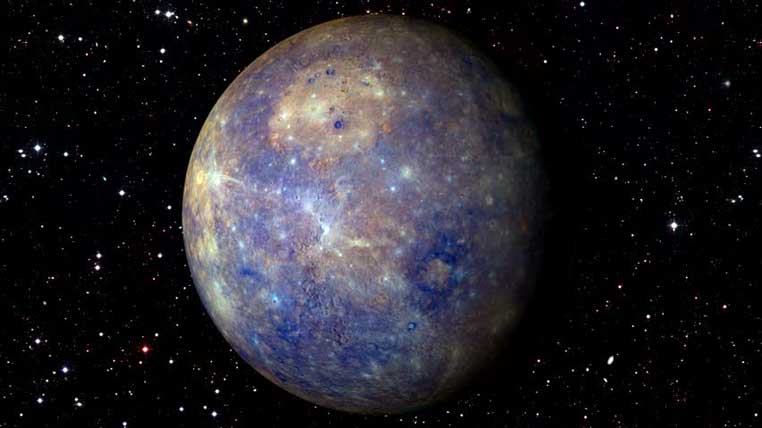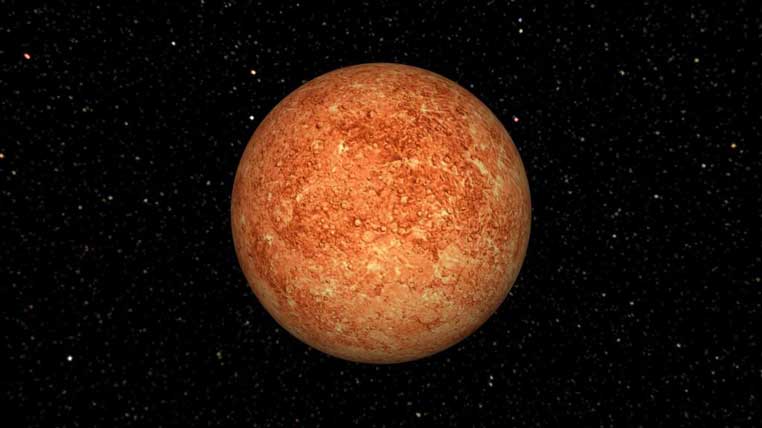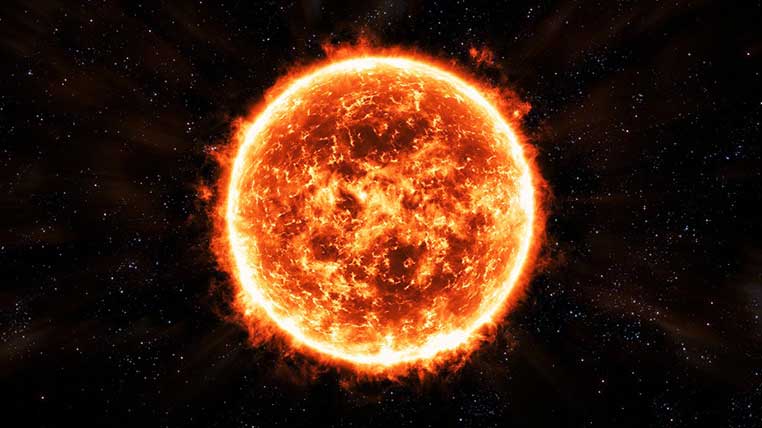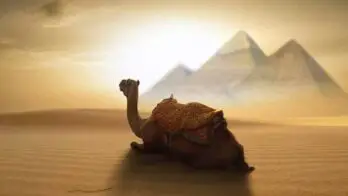The discovery of the elliptical motion of the Earth and the other planets around the Sun contributed to the emergence of the term “solar system” (which includes the Sun, planets, natural satellites, and other non-stellar objects).
The English term “planet” is derived from the French language, planète, and the Latin language, “planeta,” and means “wandering star” (or “moving star”), in opposition to the stars that appear motionless in the sky.
This apparent movement of the planets in the sky, from one night to the next, has been observed since several thousand years ago.
Still, the complexity of the movement remained a mystery to scholars and astronomers of the past.
The solar system is located in one of the outer arms of the Milky Way (more precisely, in the Orion Arm), a galaxy that contains between 100 and 400 billion stars. It formed 4.6 billion years ago due to the gravitational collapse of a giant molecular cloud.
The most massive object is the central star – the Sun, and the second most massive object is the planet Jupiter.

What is the largest planet in our solar system?
The largest planet in our solar system is Jupiter, with a diameter of 142,800 kilometers (about 88,700 miles), which is about eleven times the diameter of Earth.
Jupiter also has an immense mass at 318 times that of Earth and a massive volume at 1,300 times that of Earth. In fact, Jupiter is so expansive that it could easily fit all the other planets in the solar system inside it… twice!
Jupiter is the fifth planet from the Sun and the fourth brightest object in the sky after the Sun, Moon, Venus, and Mars, and it has been known since ancient times.
For instance, in 1610, Galileo Galilei and Simon Marius discovered four of the planet’s largest satellites: Europa, Io, Callisto, and Ganymede.
Jupiter is a very “hostile” planet, with its atmosphere composed of toxic gases, mainly hydrogen and helium, and its surface primarily covered by an ocean of liquid helium.
The gas giant is entirely covered by huge clouds that move around the planet at high speeds in the opposite direction to the direction of the planet’s rotation.
This generates enormous storms, the largest known as the “Great Red Spot” and moving around the equator.

What is the closest planet to the Sun?
The closest planet to the Sun is Mercury.
Interestingly, although Mercury is very close to the Sun, it is estimated that there are between 100 and 1,000 billion tons of ice on its surface.
According to NASA specialists, Mercury’s equator registers temperatures of 800 degrees Fahrenheit, about 420 degrees Celsius.
At the poles, however, in some craters that never receive the Sun’s rays, the temperature drops to -187 degrees Celsius, allowing the formation of ice blocks.
Like Earth, Mercury is a telluric (rocky) planet. It measures approximately 4,894 kilometers (about 3,040 miles) in diameter.
The planet mainly comprises metals (about 70%) and silicates (approximately 30%).
Physically, Mercury is quite similar to our natural satellite, the Moon. The planet’s surface is full of craters and has an almost non-existent atmosphere.
Mercury’s solid iron core generates a magnetic field 100 times weaker than Earth’s.

What is the smallest planet in the solar system?
The answer to this question remains controversial. Until 2006, when Pluto was still considered the ninth planet in the solar system, the answer to the question would have been “Pluto.”
On August 24, 2006, following a decision by the International Astronomical Union that redefined the term “planet,” Pluto was classified as a dwarf planet.
Furthermore, Pluto and its satellite Charon are now considered a binary system because the barycenter of the orbits is outside the two cosmic bodies.
Therefore, following the decision of the International Astronomical Union, Mercury came to be considered the smallest planet in the solar system.
However, the resolution is not final.
Recently, part of the scientific community has challenged the decision made in 2006, and NASA announced the start of procedures to reintegrate Pluto as a planet.
But until that happens, Mercury remains the smallest planet in the solar system.

How many planets are in the solar system?
The eight planets, in order of distance from the Sun, are Mercury, Venus, Earth (Terra), Mars, Jupiter, Saturn, Uranus, and Neptune.
In addition to the eight planets, NASA researchers have theorized the existence of a ninth planet, tentatively named “Planet A.”
According to a study published in the Astronomical Journal, “Planet A” would be on the solar system’s edge at a distance of at least 200 Astronomical Units (AU).
An AU is a unit of length defined as the length of the semi-major axis of the Earth’s orbit around the Sun; this is approximately 150 million kilometers (about 93 million miles).
According to researchers Michael E. Brown and Konstantin Batygin of the California Institute of Technology, “Planet A” would be so far from the Sun that a complete orbit would take between 10,000 and 20,000 years to complete.

How many stars are in our solar system?
The Sun is the only star in the solar system and by far its most important component.
It has a mass 332,900 times that of Earth and produces, in its core, a temperature and gravitational force high enough to support nuclear fusion.
Moreover, compared to the rest of the objects in the solar system, the total mass of the eight planets, their natural satellites, all the asteroids, meteorites, and comets, as well as the interplanetary dust orbiting the Sun, represent only 0.14% of the mass of the entire solar system.
Interesting read: Unraveling the Desert Mysteries: 7 Incredible Discoveries from Around the World
In contrast, the mass of the Sun constitutes the remaining 99.86%.
According to astronomers, the age of the Sun is approximately 4.6 billion years, and it is halfway through its life cycle.
Over the next 5 billion years, as the hydrogen reserves run out, the Sun will turn into a red giant and then a white dwarf, causing the destruction of the entire solar system.

What is the order of the planets from the Sun?
The order of the planets from the Sun, starting with the planet closest to the Sun and ending with the farthest, is as follows:
- Mercury
- Venus
- Earth
- Mars
- Jupiter
- Saturn
- Uranus
- Neptune
If we were to include other significant cosmic objects in the list, the order becomes:
- Mercury
- Venus
- Earth
- Mars
- The Asteroid Belt
- Ceres
- Jupiter
- Saturn
- Uranus
- Neptune
- Pluto
- The Kuiper Belt
- Haumea
- Makemake
- Eris
- The Scattered Disk

What is the coldest planet in the solar system?
Many would expect the answer to this question to be Neptune, as it is the farthest planet from the Sun.
However, distance from the Sun does not always prove to be a determining factor; the coldest planet in the solar system is Uranus, with the lowest temperature recorded as -224 degrees Celsius (about -371 Fahrenheit).
Along with Jupiter and Saturn, Uranus is a gas giant, and like the other gas giants, it gives off more heat from its core than it receives from the Sun.
Uranus has a much cooler core compared to the cores of the other gas giants, with temperatures reaching about 4,700 degrees Celsius (about 8,491 Fahrenheit), five times lower than the temperature of Jupiter’s core.

What is the hottest planet in the solar system?
As far as our solar system is concerned, Mercury is the closest – and therefore hottest – planet to the Sun.
Here, temperatures rise, during the day, up to 420 degrees Celsius (787 degrees Fahrenheit), while temperatures of up to 5,500 degrees Celsius (9,931 degrees Fahrenheit) are recorded on the surface of the Sun.
However, there are also planets much hotter than Mercury in the Milky Way.
For example, about 650 light years from our Earth, in the constellation Swan (lat. Cygni), scientists have discovered a gas giant called Kelt-9b.
It is twice the size of Jupiter and is very close to the star α Cygni (Deneb), with temperatures on its surface reaching 4,300 degrees Celsius (7,771 degrees Fahrenheit).
What is the solar system made of?
The solar system consists of the central star (the Sun) and its planetary System (the eight planets and their natural satellites).
It also includes other cosmic objects and bodies (such as the dwarf planet Pluto and its Moon Charon, the asteroid Ceres, Eris, Haumea, Makemake, the Asteroid Belt, etc.).
Our solar system is located in the Orion Arm – one of the outer arms of the Milky Way galaxy.
The galaxy is classified by scientists as a medium-sized galaxy and contains between 100 and 400 billion stars and more than 1,000 nebulae.

The solar system’s age is estimated to be 4.6 billion years, and it formed from the gravitational collapse of a massive molecular cloud.
What are the areas of the solar system?
The solar system comprises several so-called “zones” or “regions.”
The first zone is that of the minor inner planets – Mercury, Venus, Earth, and Mars – also called telluric planets due to their composition, consisting mainly of rocks and metal.
The second area is known as the Asteroid Belt.
It consists of debris left over from the solar system’s formation, which failed to combine into massive cosmic structures due to Jupiter’s gravitational pull.
The most important cosmic body in the Asteroid Belt is Ceres.
The third zone is that of the outer planets – Jupiter, Saturn, Uranus, and Neptune.
The first two planets – Jupiter and Saturn – are also called gas giants due to their composition, consisting mainly of hydrogen and helium.
Uranus and Neptune are composed primarily of methane, ammonia, and water.
The fourth and final area is known as the trans-Neptunian region (the area beyond Neptune) or the “outer solar system” and is largely unexplored.
This region contains a multitude of small worlds (most bodies here are five times smaller in diameter than Earth and much smaller in mass than the Moon) and is composed primarily of rock and ice.

Which planet has the most natural satellites?
Jupiter is the planet with the most natural satellites – 67 known satellites.
Jupiter’s largest moons are Ganymede, the largest satellite in the solar system, larger than Mercury, Callisto, Io, Europa, Amalthea, Metis, Thebes, or Adrastea.
Jupiter is followed by Saturn, with 62 known satellites, the most important of which are Titan and Enceladus, and Uranus, with 27 known satellites, the largest being Titania, Oberon, Umbriel, Ariel, and Miranda.

What is the temperature of the Sun?
The Sun is, by far, the largest and brightest object in the solar system. It is classified as a G2 yellow dwarf according to the Hertzsprung–Russell diagram, which plots the stars’ brightness and their surface temperature.
Its surface temperature is about 5,500 degrees Celsius (9,931 degrees Fahrenheit), while the temperature in the core rises to 15 million degrees Celsius.
Interesting read: Human Evolution Controversies: Did Aliens Genetically Engineer Humans in Ancient Times? Unraveling the Mystery
Recently, the hottest star in the Milky Way was identified.
Using the Hubble telescope, astronomers from the University of Manchester discovered a star located about 3,500 light-years from Earth in the center of the Bug Nebula, in the constellation Scorpius.
According to Professor Albert Zijlistra, the star is 35 times hotter than the Sun, with temperatures of 200,000 degrees Celsius registered on its surface!

What is the most exciting thing in the solar system?
The most interesting thing in the solar system is the presence of other planets and moons.
Our solar system is home to eight planets, dozens of moons, hundreds of thousands of asteroids, comets, and other small bodies.
This variety of celestial bodies, each with unique characteristics, provides us with plenty of fascinating sights to explore.
From the gas giant planets with their many moons to the rocky worlds like Earth, the solar system offers an incredible variety of places to explore and study.

What is the order of the planets from smallest to largest?
1. Mercury is the smallest planet and has no moons. It has a rocky surface and is the closest planet to the Sun.
2. Venus is the second smallest planet. It has a thick atmosphere of primarily carbon dioxide and is the hottest planet in the solar system.
3. Earth is the third smallest planet, and it is the only planet known to have liquid water on its surface and is home to many different life forms.
4. Mars is the fourth smallest planet in the solar system. It has a thin atmosphere and is covered in dust and sand.
5. Jupiter is the fifth-largest planet and is the largest of the gas giants. It has a thick atmosphere and primarily consists of hydrogen and helium.
6. Saturn is the sixth-largest planet and the second-largest of the gas giants. Like Jupiter, it has a thick atmosphere composed mainly of hydrogen and helium.
7. Uranus is the seventh-largest planet in the solar system and is the third-largest of the gas giants. It has a thinner atmosphere composed mainly of hydrogen, helium, and methane.
8. Neptune is the eighth-largest planet in the solar system and is the fourth-largest of the gas giants. It has a thin atmosphere composed mainly of hydrogen, helium, and methane.

Which planet from the solar system is the brightest?
The brightest planet in our solar system is Venus.
Venus is the second planet from the Sun and the sixth-largest planet in the solar system. It is the second-brightest natural object in the night sky after the Moon and is sometimes referred to as the “Morning Star” or the “Evening Star.”
Venus is the second-closest planet to Earth, making it the most suitable world for exploration.
Venus has a thick atmosphere composed primarily of carbon dioxide and sulfuric acid. Its atmosphere is much denser than Earth’s, and its surface pressure is 90 times higher.
The planet’s average surface temperature is 462 degrees Celsius (863 degrees Fahrenheit), making it the hottest world in the solar system.
The atmosphere of Venus is made up of clouds of sulfuric acid droplets and is also very reflective, which is why it is so bright in the night sky.
Venus has a slow rotation, with a day lasting 243 Earth days. Its rotation is retrograde, which means it rotates in the opposite direction to most other planets. It also has the most circular orbit of any planet in the solar system.
Venus has no moons, and there is no evidence of any life on the planet.
The surface of Venus is covered in volcanoes, mountains, and plains. Its core comprises a metallic core surrounded by a mantle of silicate rocks.
Venus has been studied by many spacecraft over the years, such as Mariner 2, Pioneer Venus, and Magellan.
These spacecraft have provided valuable information about the Venusian environment and its atmosphere and have also revealed evidence of volcanic activity on the planet.
At Ancient Theory we only use trusted sources to document our articles. Such relevant sources include authentic documents, newspaper and magazine articles, established authors, or reputable websites.
- Solar System - wikipedia.org. [Source]
- Fraser Cain - Officials Propose 12 Planets in the Solar System. universetoday.com.
- Matt Williams - What is the Biggest Planet in the Solar System? universetoday.com.
- E. V. Pitjeva and E. M. Standish - Proposals for the masses of the three largest asteroids, the Moon-Earth mass ratio, and the Astronomical Unit. [Source]
- Sun: Facts & Figures - National Aeronautics and Space Administration (NASA). [Source]
- The Solar System Explained. National Geographic.
- Solar System - britannica.com.


